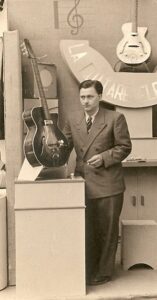Stimer guitar pickups and amplifiers
Jean Guen, was French Radio Engineer that created the Stimer Brand and his first guitar pickup in 1946. These first prototypes were the P46 and R46, and they were followed by the worldwide famous STIMER guitar pickups and amplifiers, mostly popularized by Django Reinhardt.


Jean‘s brother, Yves Guen, was the creator of STIMER guitar pickup in 1948, becoming the first french guitar pickup manufacturer.

This first pickup, was especially designed for Django Reinhardt, to be used on his Selmer guitar. (this pickup has been copied by several foreign and French brands all these years).
Django Reinhardt collaborated for this first Stimer guitar pickup construction.

At that time Django Reinhardt, Stéphane Grappelli, Henri Crolla, Marcel Bianchi, Roger Chaput, Les Paul, Barney Kessel among other artists used stimer pickups and amplifiers.
Yves Guen created several pickups, microphones and amplifiers.

After the ST48, Guen developed several devices:


The vintage Stimer guitar pickup S 51 with sliding rod.
The famous “Modele Django”, created after Django`s death It slides on two bars between the neck and the bridge, which allows the sound to be picked up at different harmonic positions of the strings.


A Stimer accordion microphone.

A studio microphone.
A violin microphone, wich was used by Grappelli and many other violinists.
The SYG2 for electric guitar
The S80.
Different electric guitar pickups for Stratocaster and Gibson versions
Yves Guen also developed the world famous guitar amplifiers Stimer M6 M10 and M12 models



Which guitar amplifiers were created by Yves Guen?
The A series, the very first Stimer tube guitar amp, which were in a varnished box.
The M series with tubes in a beige sheathed box.
The Stimer guitar amp models M6, M8, M10, M12.
The Special Stimer M12 amplifier with tubes used by Django Reinhardt
Nuance and Nuance V.
The S series with tubes S11, S12, S13, S17, S17v, S20, S25.
The Haarlem series, Aristocrat, the Recording, The Island reverb.
What happened with the STIMER trademark?
In 1986, Yves Guen passed away, and Christian continued the company with his mother.
In 1994, the company went on hold.
Years later in 2004, a luthier (not related to Guen) registered the trademark STIMER to identify guitar pickups.
Since then, Christian Yves Guen, Ive`s Guen son (Born in 1946, France) started using the brand name “Yves Guen Original ” to identify his products, which is the name of the founder of Stimer.
Christian Yves Guen spent his childhood in the workshops of Yves Guen, located in Courbevoie, Maisons Laffitte, then Sartrouville, France.
He personal recalls his starts on his website:
“…It was in this workshop that I made my first microphones at the age of 10 on his advice, at that time we were in Courbevoie. He taught me his methods, his tricks, the choice of components, the location of parts, his method of manufacture, and in summary his know-how to make a good microphone. My knowledge of microphones allows me to tell you exactly what year your microphone or amp is and of course if it’s a real Stimer Yves Guen microphone. As I accompanied my father to all the exhibitions, I built up a large collection of catalogs on guitars and amps from other brands of the time. Many young music journalists come to see me to ask me for information on these brands that no longer exist. Not many of us these days have experienced the beginning of international musical electrification.
After my engineering studies in 1971, I decided to continue manufacturing Stimer tube microphones and guitar amplifiers with him. It was 20 exciting years that allowed me to develop new models of guitar pickups as well as a series of ST7 effects pedals that are very sought after today. I have also developed a range of high power tube amps. Many musicians came to Sartrouville to modify their tube amp, to have a custom sound. This allowed me to have a perfect knowledge of tube amps. We remain faithful to this amplification technology which has no equivalent and I explain why in the M12 amp section, why a transistor amp cannot have the sound of a tube amp.”
(Info: https://stimer.fr )







